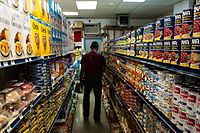
Photo from wikipedia
The demand for convenience and the increasing role of digital technology in everyday life has fueled the use of online food delivery services (OFD’s), of which young people are the… Click to show full abstract
The demand for convenience and the increasing role of digital technology in everyday life has fueled the use of online food delivery services (OFD’s), of which young people are the largest users globally. OFD’s are disrupting traditional food environments, yet research evaluating the public health implications of such services is lacking. We evaluated the characteristics and nutritional quality of popular food outlets on a market-leading platform (UberEATS®) in a cross-sectional observational study conducted in two international cities: Sydney (Australia) and Auckland (New Zealand). A systematic search using publicly available population-level data was used to identify geographical areas with above-average concentrations (>30%) of young people (15–34-years). A standardized data extraction protocol was used to identify the ten most popular food outlets within each area. The nutritional quality of food outlets was assessed using the Food Environment Score (FES) (range: −10 ‘unhealthiest’ to 10 ‘healthiest’). Additionally, the most popular menu items from each food outlet were classified as discretionary or core foods/beverages according to the Australian Dietary Guidelines. The majority of popular food outlets were classified as ‘unhealthy’ (FES range −10 to −5; 73.5%, 789/1074) and were predominately takeaway franchise stores (59.6%, 470/789, e.g., McDonald’s®). 85.9% of all popular menu items were discretionary (n = 4958/5769). This study highlights the pervasion and accessibility of discretionary foods on OFD’s. This study demonstrated that the most popular food outlets on the market-leading online food delivery service are unhealthy and popular menu items are mostly discretionary foods; facilitating the purchase of foods of poor nutritional quality. Consideration of OFD’s in public health nutrition strategies and policies in critical.
Journal Title: Nutrients
Year Published: 2020
Link to full text (if available)
Share on Social Media: Sign Up to like & get
recommendations!